Through the interweaving of materials of diverse sources and characteristics suggested as entangled bodies, Bev Butkow’s work advocates a better humanity.
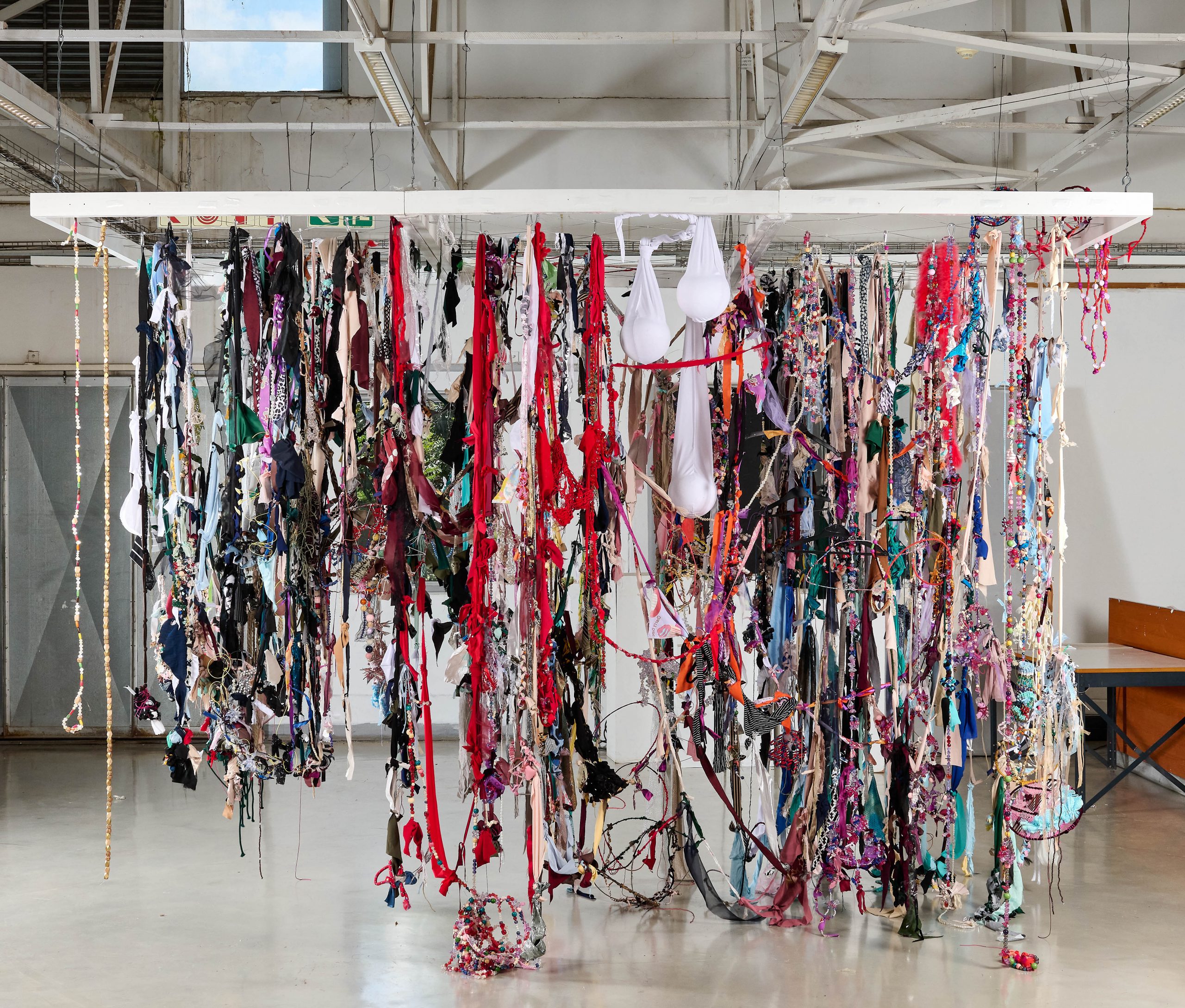
X marks the spot, but it also cancels the spot, it is both a focal point and its erasure. This paradox is one that we suppress today in our fervent need for certainty. Ours is an unconditional world, at odds with curiosity, driven by hysterical excess which we disguise as an absolute. This explains the return of dogmatism-tribalism-nativism-populism, and the resentment it feeds upon. Balkanised, trapped in self-serving silos, we lack the grace to become the others of ourselves, preferring stunted certainty to boundless mystery. As a consequence, we no longer know the purpose of love. Instead, as Pankaj Mishra defines it, ours is an ‘Age of Anger’ in which ‘Well-worn pairs of rhetorical opposites, often corresponding to the bitter divisions in our societies, have once again been put to work: progressive vs. reactionary, open vs. closed, liberalism vs. fascism, rational vs. irrational’.
It is against this ‘current disorder’ that Bev Butkow positions her art. ‘eXe’ – a shorthand for ‘embodied-entanglements / entangled embodiments’ – is Butkow’s active challenge against an exclusionary and divisive vision. Her visual language, as much as it is moral, celebrates tactility, interconnection – a human and extra-human knotting which, as easily, unravels. This is because she is as drawn to a rhythmic consensual human fabric as she is to its ‘unlearning’. A paradox? Certainly. In her world, however, connection is as profound as it is perilous. Connection – its creative making-and-unmaking – comes with risk. We see this in the raw language of her fretwork – frames, with supporting canvas removed, twisted in the act of weaving. A new tension arises. Instead of a flat plane, we now have a threaded journey and inquiry into substance, and the void which informs the visibility and meaning of all things. It is weaving, as an action, that accounts for ‘the tactility of the moment’. If, for Butkow, the works are ‘unresolved’, it is because there is ‘no need for answers’ – at least, not answers that could explain away ‘the tactility of the moment’. It is her haptic disposition, her need for things that refuse containment – notwithstanding the frame as a supportive structure – that matters most. If her defining MO requires the frame and emptiness, the structure and the void, it is because what she gifts us is, in its very nature, partial. That, furthermore, she chooses to off-set her sculptural forms through the play of light and shadow, as well as videography, is a further reminder that this illumined play evokes ‘an unconscious circling closer and closer … light and shadow’, elements as integral to being as they are ephemeral.
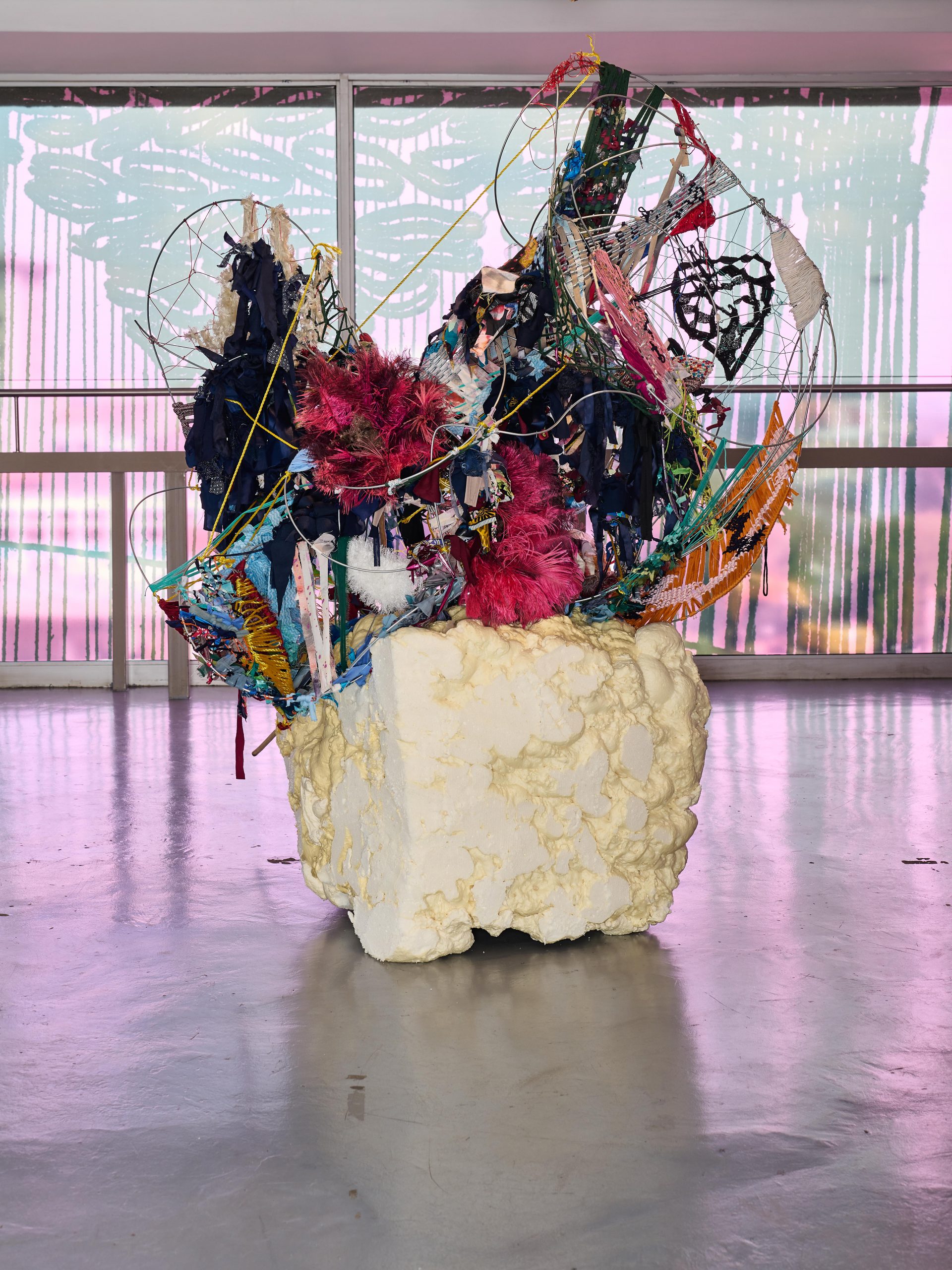
As the poet John Keats reminds us, when we step ‘into a sort of oneness’, we forget that there are ‘richer entanglements … enthralments far more self-destroying’ that lead to a greater ‘intensity’ and a crowning ‘love and friendship’. In short, ‘oneness’, the metaphysical grail, is only possible at the limit of being, as a penumbral promise. If it is the source, for Keats, of ‘love and friendship’, this, in truth, is only ever attainable through entanglements. Hence Butkow’s paradigmatic cipher – ‘eXe’.
Today, textile-based works have emerged as a defining genre and taste in the contemporary art world. It supposes a blurring of craft, design, and art, but, more profoundly, it speaks to an irresistible curiosity and experimentation – an entangled quest for ‘oneness’.
However, paradox, in-and-of-itself, is not enough. What human entanglement promises us is human betterment, grace, growth, innovation. To understand Butkow’s practice is to understand this core principle. Hers is a passionate reach, a hope, in the fragile midst of making-and-unmaking, that we can be joined together, no matter how precariously. If she sees her textiles as ‘expanded painting’ it is because they are never a bounded site, but, rather, incursions-experiments-adventures driven by a crowning belief in love in the fullest sense – unconditional love (Agape), romantic love (Eros), affectionate love (Philia), self-love (Philautia), enduring love (Pragma), playful love (Ludus), obsessive love (Mania). We are made up of all of these urgencies. What Butkow does is articulate them in works that manifest their complex fretwork. Both loose and wrought, her textile-based relief works reveal all the emotions that come to bare in the making of their energy field. Because what is given, what is released, is humanity-as-desire, rather than humanity as an idea. If ritual is key, it is because nothing made can be known in advance. All form is intrinsically formless. Shape is hallucination, as is density, or flatness – which is why Butkow speaks of her work as an ‘expanded painting’. This expansion, and tension, is revealed in the weaving which, as Joan Erikson reminds us, signals ‘a good life’. ‘Energy is created in the tension, the struggle, the pull and tug are everything’.
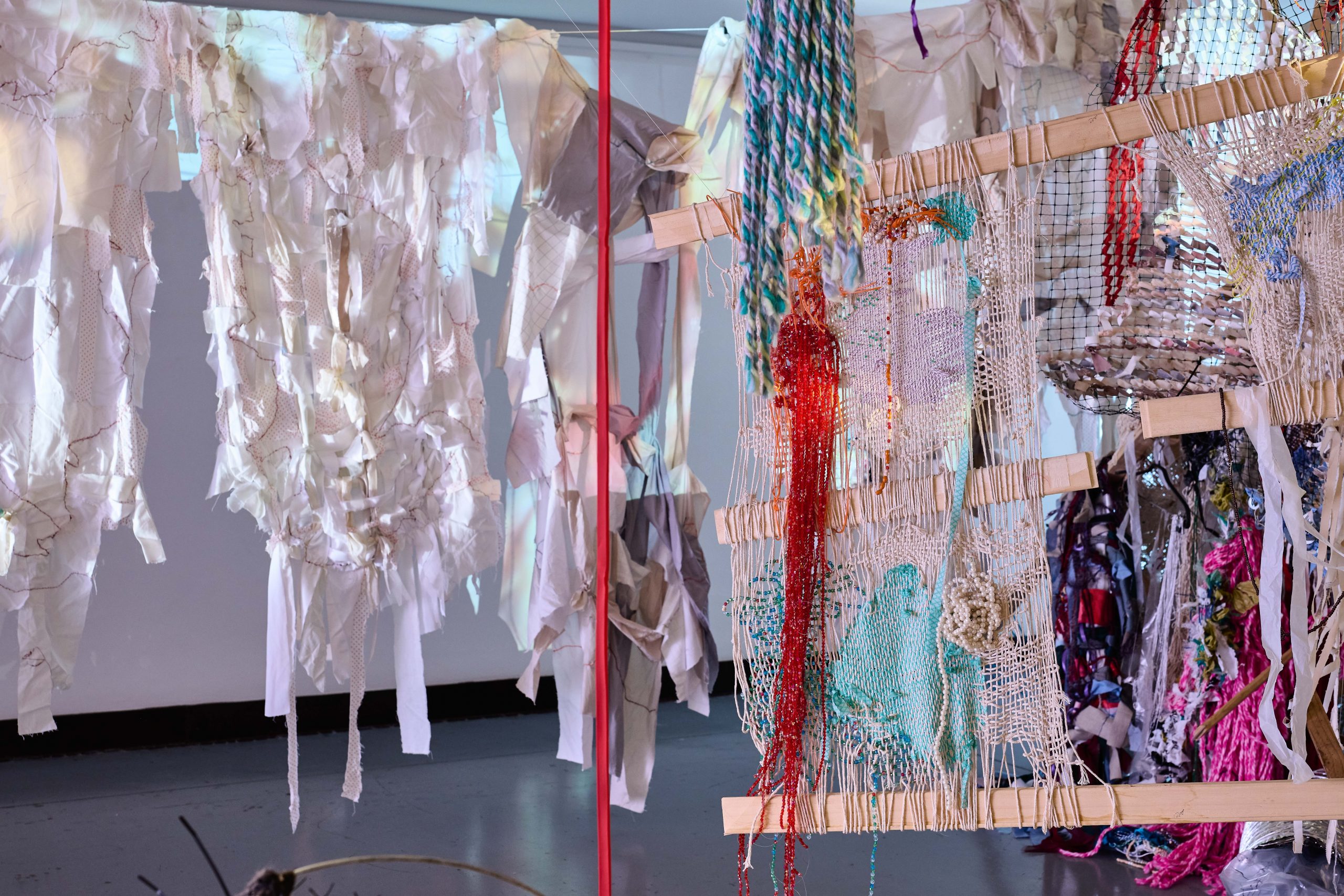
Why does painting, as a traditional convention, choose to centre us in its midst? Why can’t it open us to the infinite? Is this not because it enshrines the artist’s controlling vision, and our compliance with and subjection to that vision? If Butkow refuses the deception of convention – depth of field, say, or monumental volume – it is because she favours something far more amorphous, the boundlessness that consumes the act of making, and the void it touches in the instant that it releases this desiring force. She speaks of the ‘organic’, ‘fluid’, ‘reflexive’, ‘messy’, ‘spontaneous’, as a critical massing of unfixing forms that ‘transcend figuration and representation’. In sum, one could say that hers is a Dionysian world vision, as opposed to an Apollonian one, which advances in increments, without any controlling oversight – as a threading-unthreading-threading again. In the ‘encrusted moment of connection’, there is a tethering, because Butkow is as moved by the sublime as she is by the mundane. The materiality of weaving is the sum of a convergence – a ‘good life’.
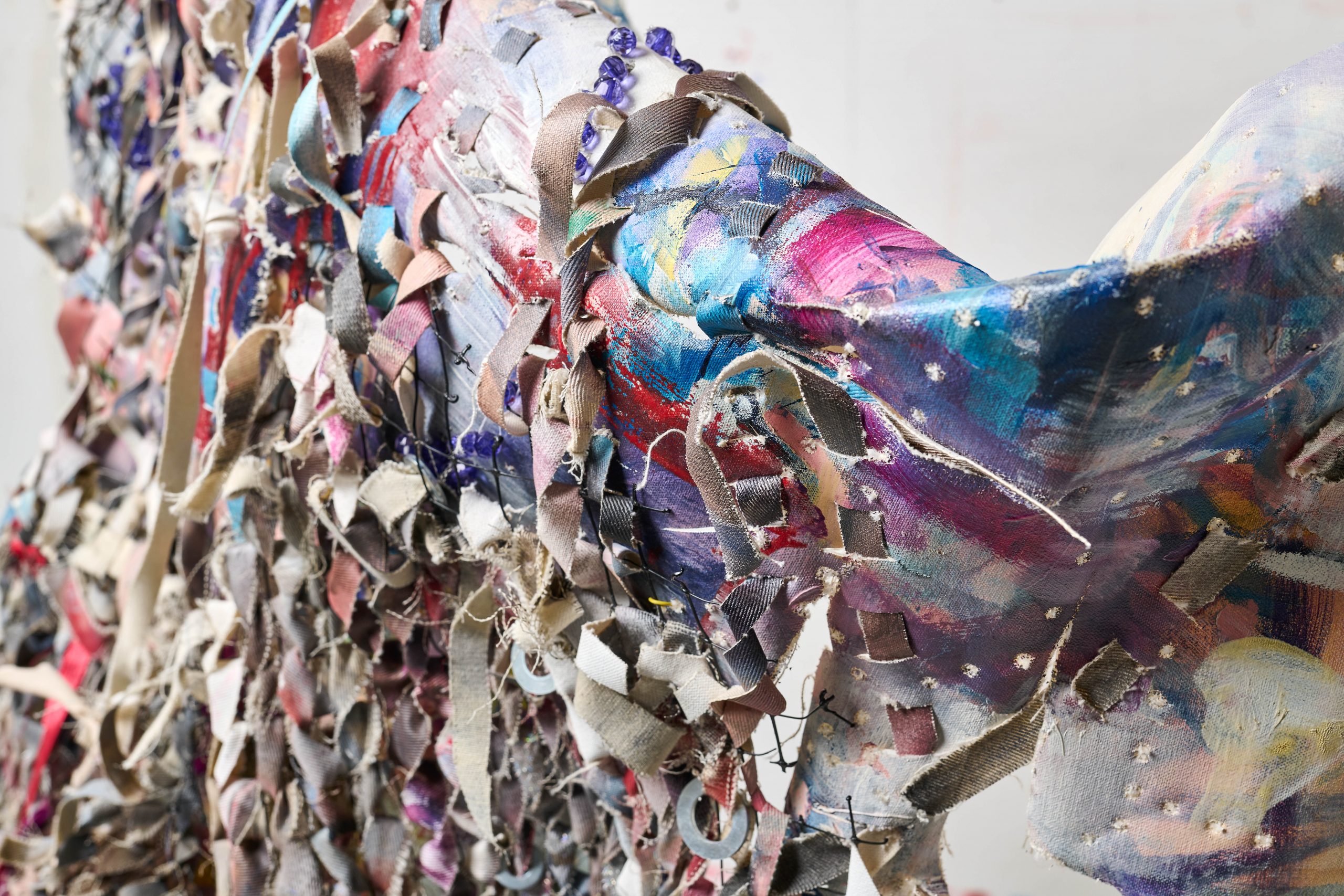
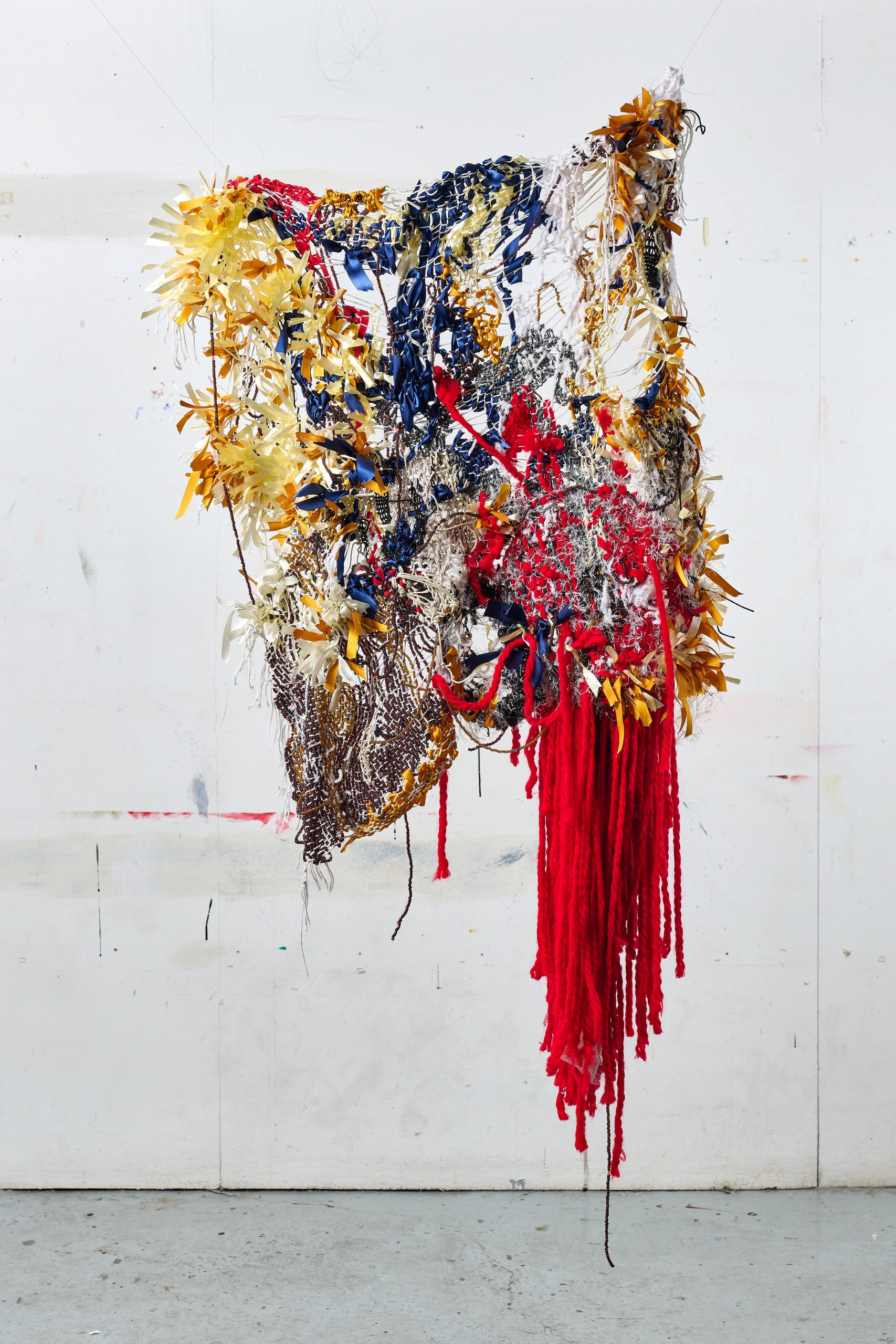
If the Feminine Principle is key – hers a meditation on the female body in space and time – it is because the artist understands womanhood as a mysterious singularity. If politics has a place in her work, then it is the politics of ‘woman’s work’. However, its expression is never representative, it is intuitive. This is because fluidity and organicity are paramount. The ‘rhythmic weaving gestures’ she holds dear speak not only to her private communion in the moment of making but to a collective creative journey, for these vast woven and painted works are never made by a single human being. Butkow’s practice, spanning decades, is age-old. Today, textile-based works have emerged as a defining genre and taste in the contemporary art world. It supposes a blurring of craft, design, and art, but, more profoundly, it speaks to an irresistible curiosity and experimentation – an entangled quest for ‘oneness’.
…it is not the fact that we waste far more than we consume that matters, or the fact that Africa is the geopolitical dumpsite for the excesses of the West, rather, she asks us to reconsider human entanglement…
‘Matereality’, a monumental group show curated by Andrea Lewis at the Iziko National Gallery in Cape Town in 2020, addressed the inextricability of matter and reality, and the criticality of this fusion in art-making both domestically and globally. There is, however, a keen realisation that it is the innovative transformation of ‘mundane materials’ on the African continent which proved to be the decisive turn. The global prominence of El Anatsui is a case in point, as is Igshaan Adams’ first solo show at the Hayward Gallery in 2021. In this regard, Butkow – a mother of four who began her art career in her forties – is part of a greater surge in interest. In her case, however, it is not the fact that we waste far more than we consume that matters, or the fact that Africa is the geopolitical dumpsite for the excesses of the West, rather, she asks us to reconsider human entanglement – why it is that the nexus of power-and-powerlessness blurs, why we are inevitably caught within ‘embodied-entanglements / entangled-embodiments’. The phrasing is vital, as is the cipher ‘eXe’. This fluid complex is as regenerative as it is hurtful. Most of all, however, I believe that Butkow is making a point that exceeds the politics of materiality. For her, there is the greater matter of our shared humanity and the ‘good life’ that inheres in the spirit of Ubuntu – in which we are what and whom we are because of others. If connection is critical, even in the moment of its unravelling, it is because Butkow seeks to return us to a greater purpose – art as a healing act of love.
–
Ashraf Jamal is a Research Associate in the Visual Identities in Art and Design Research Centre, University of Johannesburg. He is the co-author of Art in South Africa: The Future Present and co-editor of Indian Ocean Studies: Social, Cultural, and Political Perspectives. Jamal is also the author of Predicaments of culture in South Africa, Love themes for the wilderness, The Shades, In the World: Essays on Contemporary South African Art, and Strange Cargo: Essays on Art.




